1998 CADILLAC SEVILLE towing
[x] Cancel search: towingPage 72 of 378
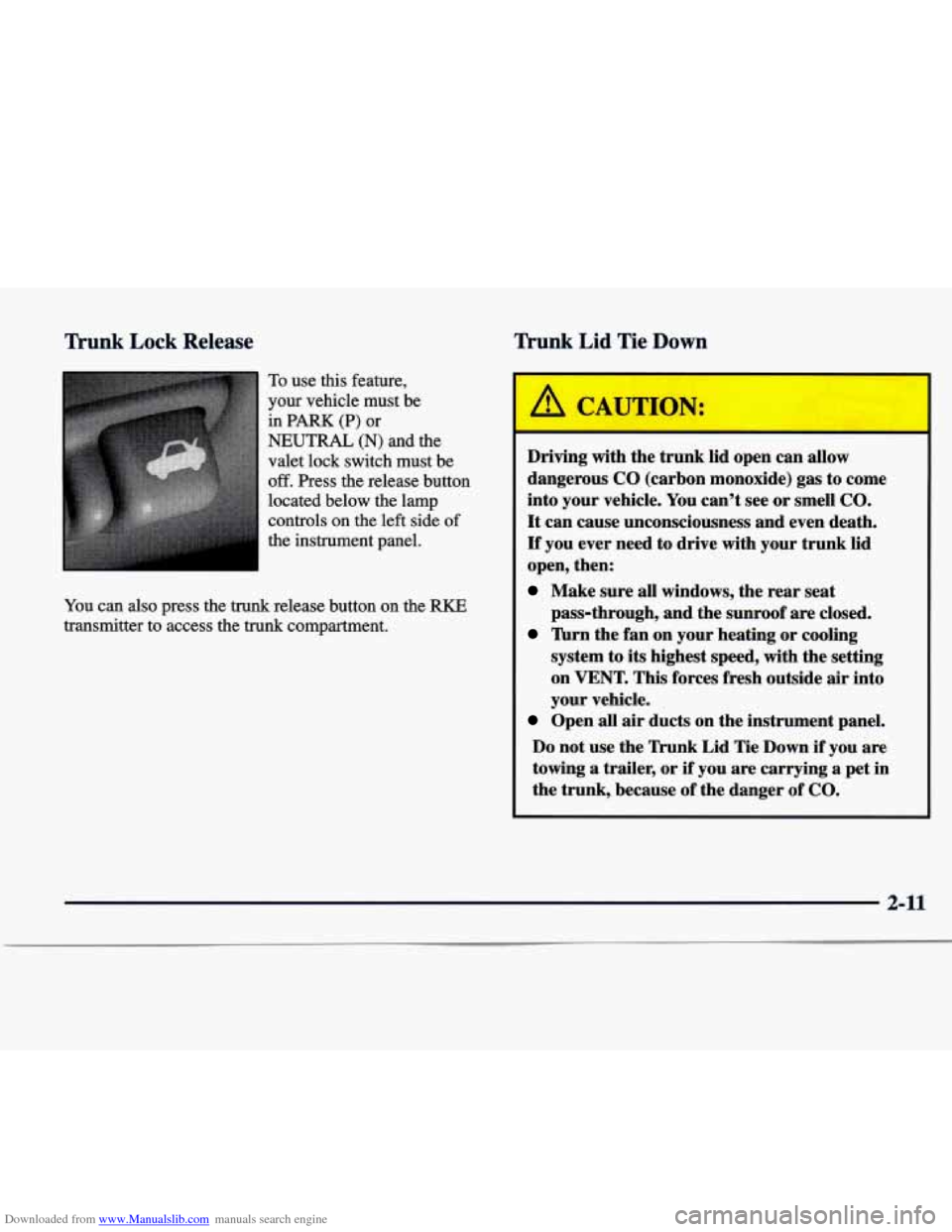
Downloaded from www.Manualslib.com manuals search engine Trunk Lock Release Trunk Lid Tie Down
To use this feature,
your vehicle must be
in
PARK (P) or
NEUTRAL (N) and the
valet lock switch must be
off. Press the release button
located below the lamp
controls on the left side
of
the instrument panel.
You can also press the trunk release button on the RKE
transmitter to access the trunk compartment.
A CAUTION:
Driving with the trunk lid open can allow
dangerous
CO (carbon monoxide) gas to come
into your vehicle. You can't see or smell
CO.
It can cause unconsciousness and even death.
If you ever need to drive with your trunk lid
open, then:
Make sure all windows, the rear seat
'hrn the fan on your heating or cooling
pass-through, and the sunroof
are closed.
system to its highest speed, with the setting
on
VENT. This forces fresh outside air into
your vehicle.
Open all air ducts on the instrument panel.
Do not use the Trunk Lid Tie Down if you are
towing a trailer, or
if you are carrying a pet in
the trunk, because of the danger of
CO.
2-11
Page 78 of 378
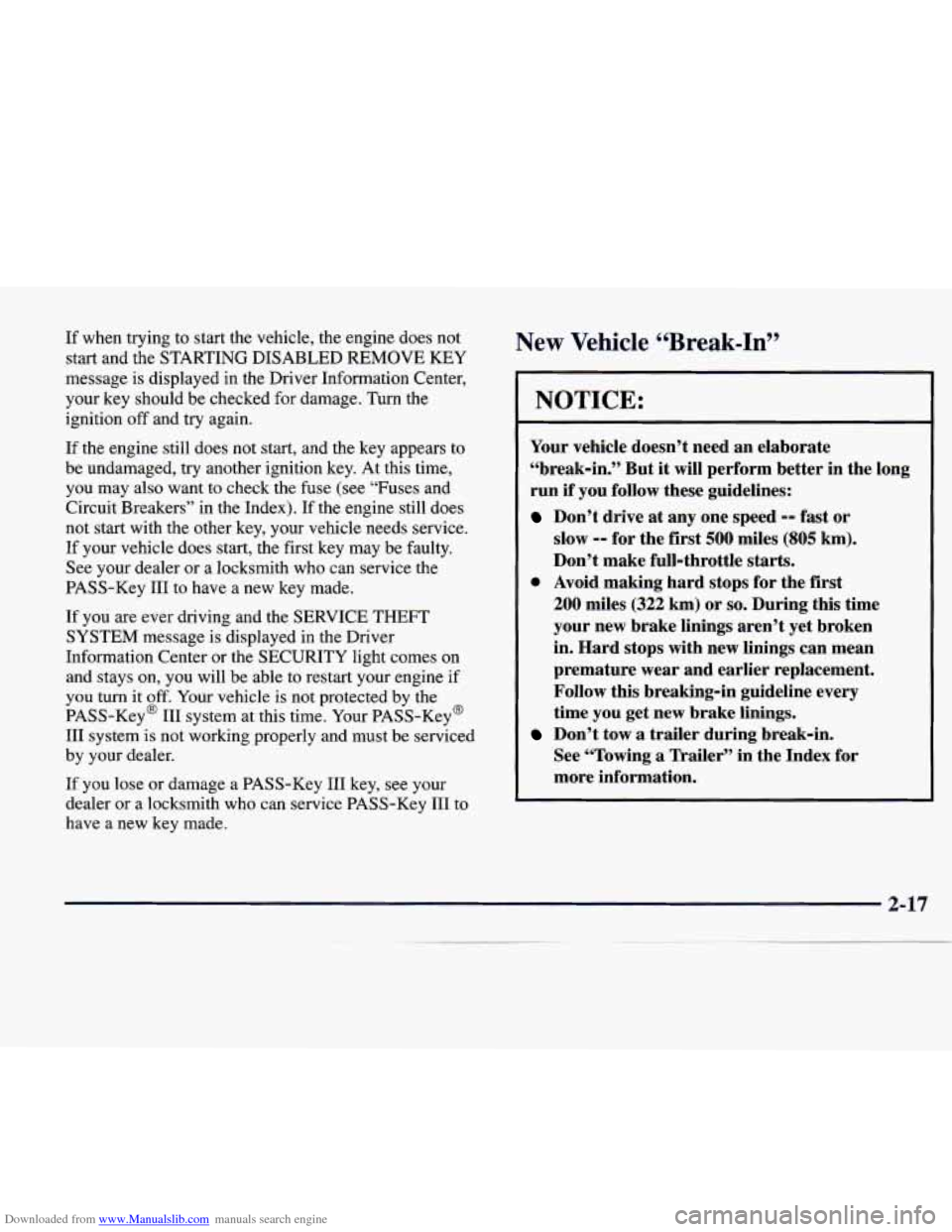
Downloaded from www.Manualslib.com manuals search engine If when trying to start the vehicle, the engine does not
start and the STARTING DISABLED REMOVE KEY
message is displayed in the Driver Information Center,
your key should be checked for damage.
Turn the
ignition
off and try again.
If the engine still does not start, and the key appears to
be undamaged, try another ignition key. At this time, you may also want to check the fuse (see “Fuses and
Circuit Breakers’’ in the Index). If the engine still does
not start with the other key, your vehicle needs service.
If your vehicle does start, the first key may be faulty.
See your dealer or a locksmith who can service the
PASS-Key
I11 to have a new key made.
If you are ever driving and the SERVICE
THEFT
SYSTEM message is displayed in the Driver
Information Center or the
SECURITY light comes on
and stays on, you will be able to restart your engine if
you
turn it off. Your vehicle is not protected by the
PASS-Key@
111 system at this time. Your PASS-Key@
I11 system is not working properly and must be serviced
by your dealer.
If you lose or damage a PASS-Key I11 key, see your
dealer or a locksmith who can service PASS-Key
111 to
have a new key made.
New Vehicle 66Break-In”
NOTICE:
Your vehicle doesn’t need an elaborate
“break-in.” But it will perform better in the long
run
if you follow these guidelines:
Don’t drive at any one speed -- fast or
slow
-- for the first 500 miles (805 km).
Don’t make full-throttle starts.
200 miles (322 km) or so. During this time
your new brake linings aren’t yet broken
in. Hard stops with new linings can mean
premature wear and earlier replacement.
Follow this breaking-in guideline every
time you get new brake linings.
See “Towing a Trailer” in the Index
for
more information.
0 Avoid making hard stops for the first
Don’t tow a trailer during break-in.
Page 81 of 378
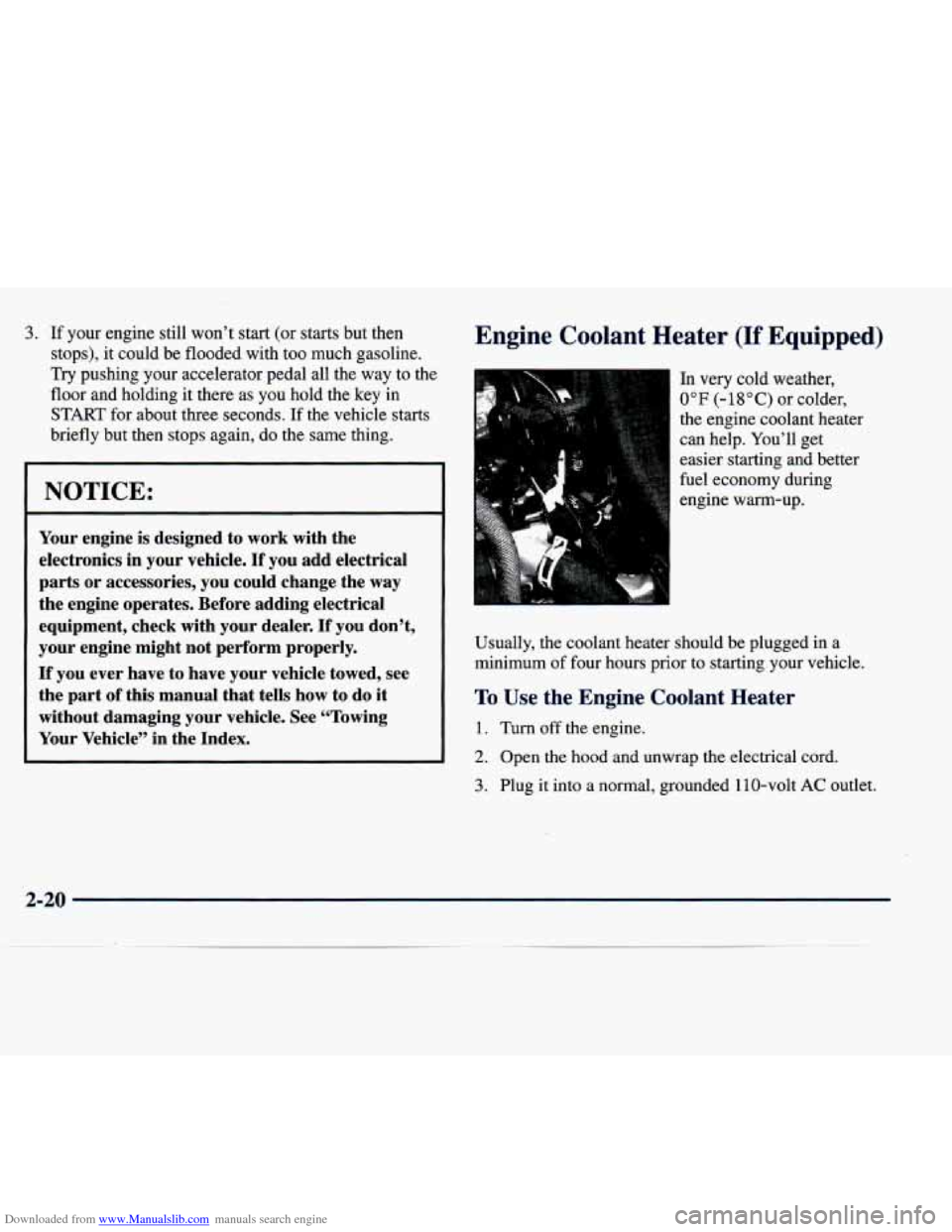
Downloaded from www.Manualslib.com manuals search engine 3. If your engine still won’t start (or starts but then
stops), it could be flooded with too much gasoline.
Try pushing your accelerator pedal all the way to the
floor and holding
it there as you hold the key in
START for about three seconds. If the vehicle starts
briefly but then stops again,
do the same thing.
I NOTICE:
Your engine is designed to work with the
electronics in
your vehicle. If you add electrical
parts or accessories, you could change the way
the engine operates. Before adding electrical
equipment, check with your dealer.
If you don’t,
your engine might not perform properly.
If you ever have to have your vehicle towed, see
the part of this manual that tells how
to do it
without damaging your vehicle. See “Towing
Your Vehicle” in the Index.
Engine Coolant Heater (If Equipped)
In very cold weather,
0°F (-18°C) or colder,
the engine coolant heater
can help. You’ll get
easier starting and better
fuel economy during
engine warm-up.
Usually, the coolant heater should be plugged in a minimum
of four hours prior to starting your vehicle.
To Use the Engine Coolant Heater
1. Turn off the engine.
2. Open the hood and unwrap the electrical cord.
3. Plug
it into a normal, grounded 110-volt AC outlet.
2-20
Page 83 of 378
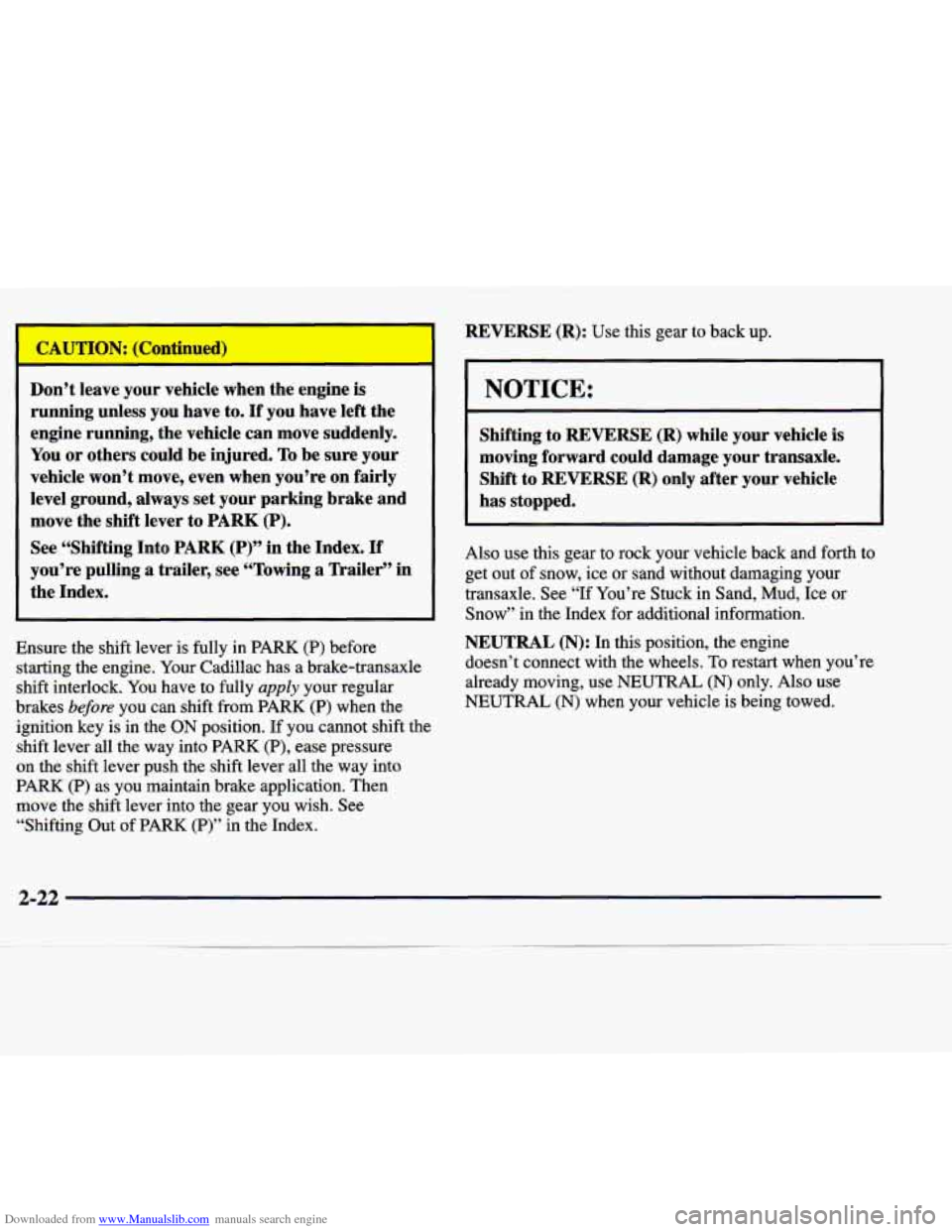
Downloaded from www.Manualslib.com manuals search engine Don’t leave your vehicle when the engine is
running unless you have to. If you have left the
engine running, the vehicle can move suddenly.
You or others could be injured. To be sure your
vehicle won’t move, even when you’re on fairly
level ground, always set your parking brake and
move the shift lever to PARK
(P).
See “Shifting Into PARK (P)” in the Index. If
you’re pulling a trailer, see “Towing a Trailer’’ in
the Index.
Ensure the shift lever is fully in PARK (P) before
starting the engine. Your Cadillac has a brake-transaxle
shift interlock. You have to fully
apply your regular
brakes
before you can shift from PARK (P) when the
ignition key is in the
ON position. If you cannot shift the
shift lever all the way into PARK (P), ease pressure
on the shift lever push the shift lever all the way into
PARK (P) as you maintain brake application. Then
move the shift lever into the gear you wish. See “Shifting Out of PARK (P)”
in the Index. REVERSE
(R): Use this gear
to back up.
NOTICE:
Shifting to REVERSE (R) while your vehicle is
moving forward could damage your transaxle.
Shift to REVERSE (R) only after your vehicle
has stopped.
Also use this gear to rock your vehicle back and
forth to
get out of snow, ice or sand without damaging your
transaxle. See “If You’re Stuck
in Sand, Mud, Ice or
Snow” in the Index for additional information.
NEUTRAL
(N): In this position, the engine
doesn’t connect with the wheels.
To restart when you’re
already moving, use
NEUTRAL (N) only. Also use
NEUTRAL (N) when your vehicle is being towed.
2-22
Page 87 of 378
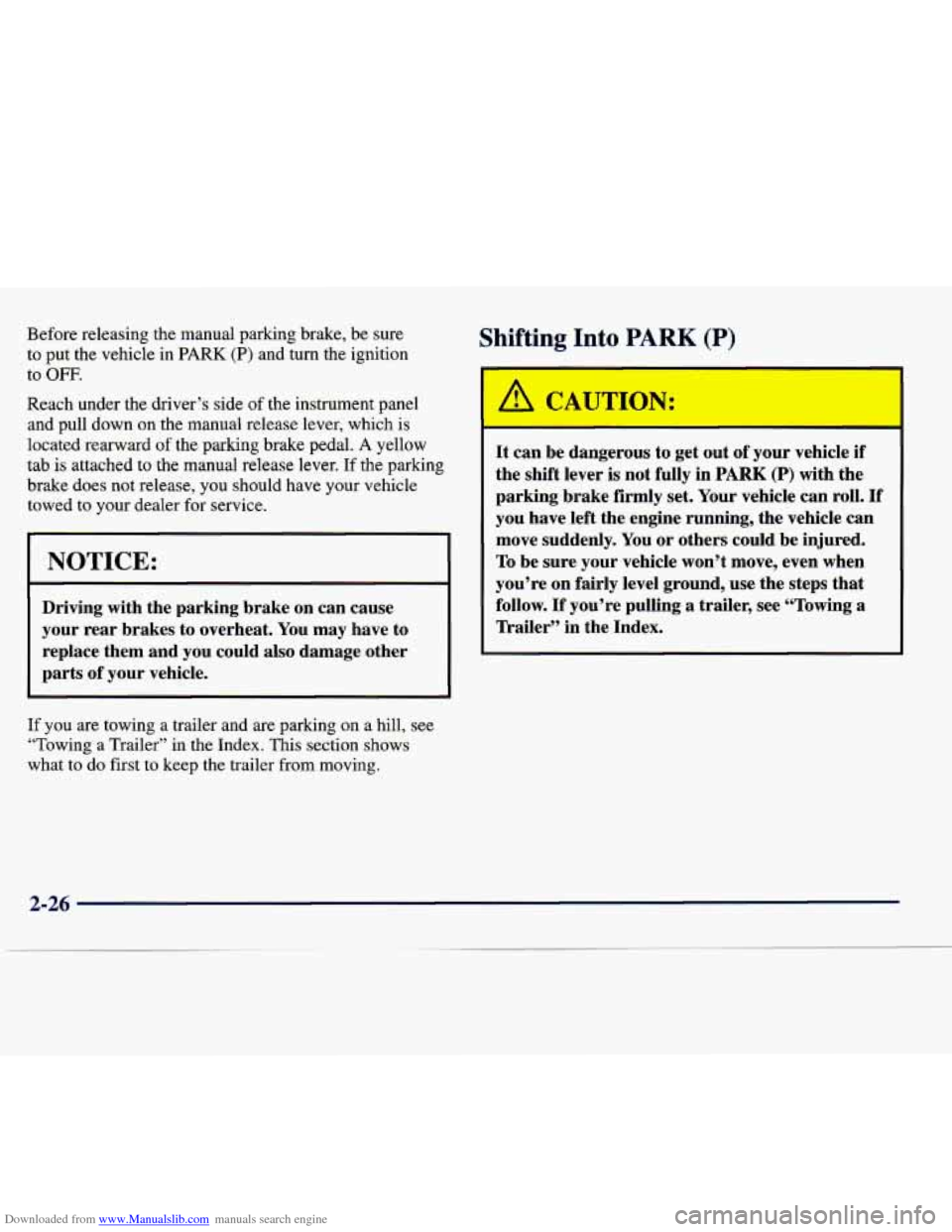
Downloaded from www.Manualslib.com manuals search engine Before releasing the manual parking brake, be sure
to put the vehicle
in PARK (P) and turn the ignition
to
OFF.
Reach under the driver’s side of the instrument panel
and pull down on the manual release lever, which
is
located rearward of the parking brake pedal. A yellow
tab is attached to the manual release lever. If the
parking
brake does not release, you should have your vehicle
towed
to your dealer for service.
NOTICE:
Driving with the parking brake on can cause
your rear brakes
to overheat. You may have to
replace them and you could also damage other
parts of your vehicle.
If
you are towing a trailer and are parking on a hill, see
“Towing a Trailer”
in the Index. This section shows
what to do first to keep the trailer from moving.
Shifting Into PARK (P)
I
’
A CAUTIO,.:
It can be dangerous to get out of your vehicle if
the shift lever
is not fully in PARK (P) with the
parking brake firmly set. Your vehicle can roll. If
you have left the engine running, the vehicle can
move suddenly. You or others could be injured.
To be sure your vehicle won’t move, even when
you’re on fairly level ground, use the steps that
follow.
If you’re pulling a trailer, see “Towing a
Trailer” in the Index.
26
Page 91 of 378
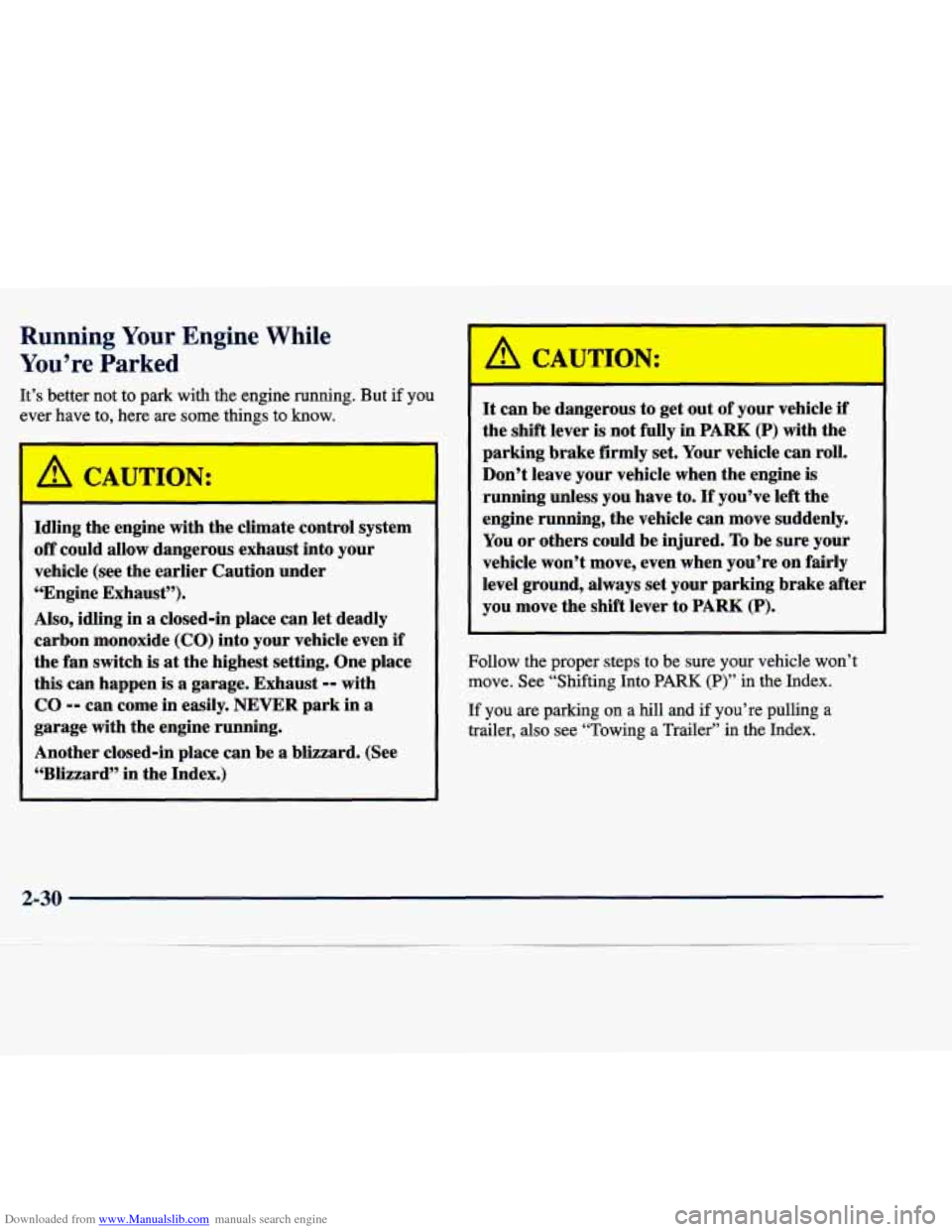
Downloaded from www.Manualslib.com manuals search engine Running Your Engine While
You’re Parked
Idling the engine with the climate control system
off could allow dangerous exhaust into your
vehicle (see the earlier Caution under
“Engine Exhaust”).
Also, idling in a closed-in place can let deadly
carbon monoxide
(CO) into your vehicle even if
the fan switch
is at the highest setting. One place
this can happen
is a garage. Exhaust -- with
CO -- can come in easily. NEVER park in a
garage with the engine running.
Another closed-in place
can be a blizzard. (See
“Blizzard” in the Index.)
It’s better not to park with the engine running. But
if you
ever have to, here are some things to know.
CAUTION:
It can
be dangerous to get out of your vehicle if
the shift lever is not fully in PARK (P) with the
parking brake firmly set. Your vehicle can roll.
Don’t leave your vehicle when the engine is
running unless you have to.
If you’ve left the
engine running, the vehicle can move suddenly.
You or others could be injured. To be sure your
vehicle won’t move, even when you’re on fairly
level ground, always set your parking brake after
you move the shift lever to
PARK (P).
Follow the proper steps to be sure your vehicle won’t
move. See “Shifting Into
PARK (P)” in the Index.
If you are parking on a hill and if you’re pulling
a
trailer, also see “Towing a Trailer” in the Index.
2-30
Page 128 of 378
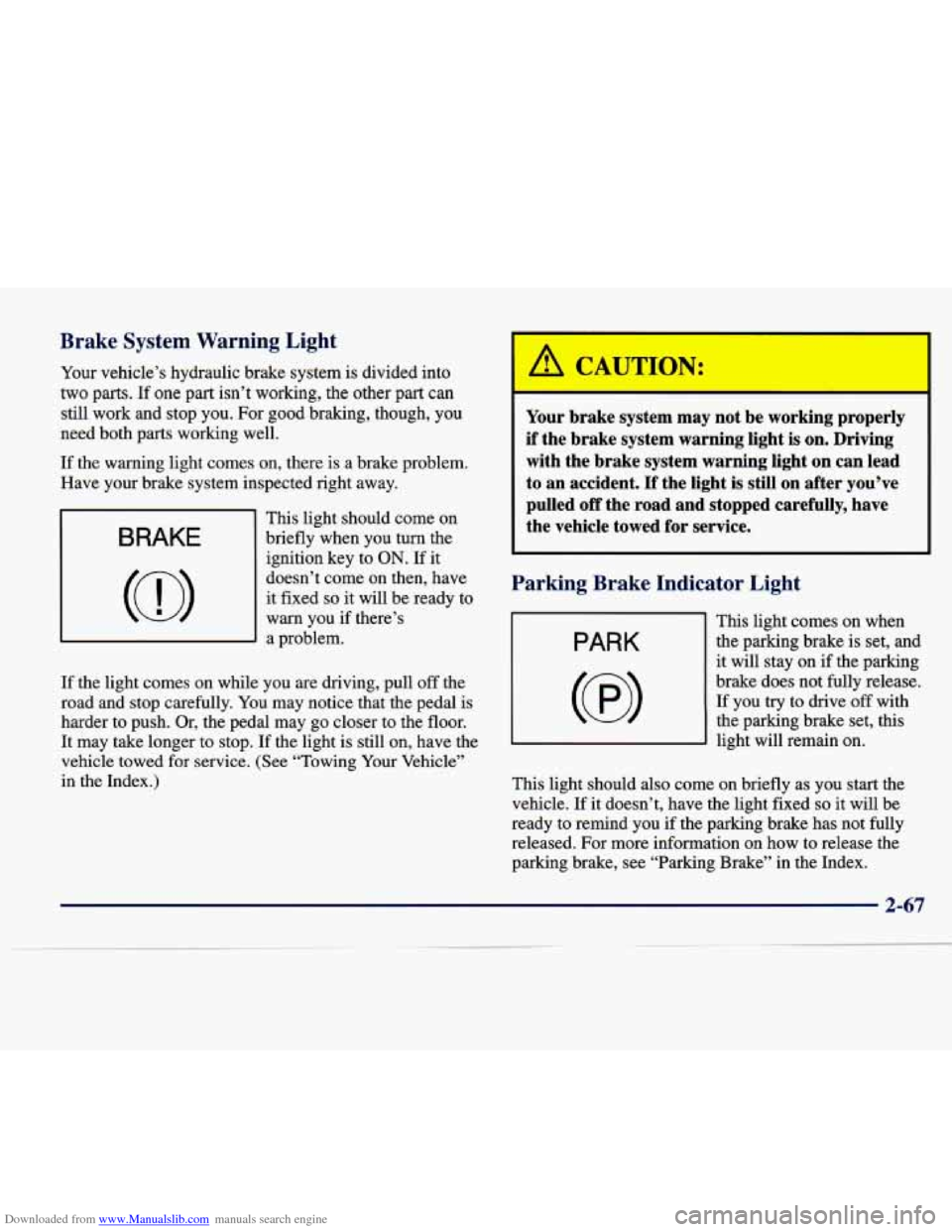
Downloaded from www.Manualslib.com manuals search engine It Brake System Warning :
Your vehicle’s hydraulic brake sy; m is divided into
two parts.
If one part isn’t working, the other part can
still work and stop you. For good braking, though, you
need both parts working well.
If the warning light comes on, there is a brake problem.
Have your brake system inspected right away.
BRAKE
This light should come on
briefly when you turn the
ignition key to
ON. If it
doesn’t come on then, have
it fixed
so it will be ready to
warn you if there’s
a problem.
If the light comes on while
you are driving, pull off the
road and stop carefully.
You may notice that the pedal is
harder to push. Or, the pedal may
go closer to the floor.
It may take longer to stop. If the light is still on, have the
vehicle towed for service. (See “Towing Your Vehicle”
in the Index.)
,a CAUTION:
Your brake system may not be working properly
if the brake system warning light is on. Driving
with the brake system warning light on can lead
to
an accident. If the light is still on after you’ve
pulled
off the road and stopped carefully, have
the vehicle towed for service.
Parking Brake Indicator Light
PARK
(@I
This light comes on when the parking brake is set, and
it will stay on if the parking
brake does not fully release.
If you try to drive off with
the parking brake set, this
light will remain
on.
This light should also come on briefly as you start the
vehicle. If it doesn’t, have the light fixed
so it will be
ready to remind you
if the parking brake has not fully
released. For more information on how to release the
parking brake, see “Parking Brake” in the Index.
2-67
Page 132 of 378
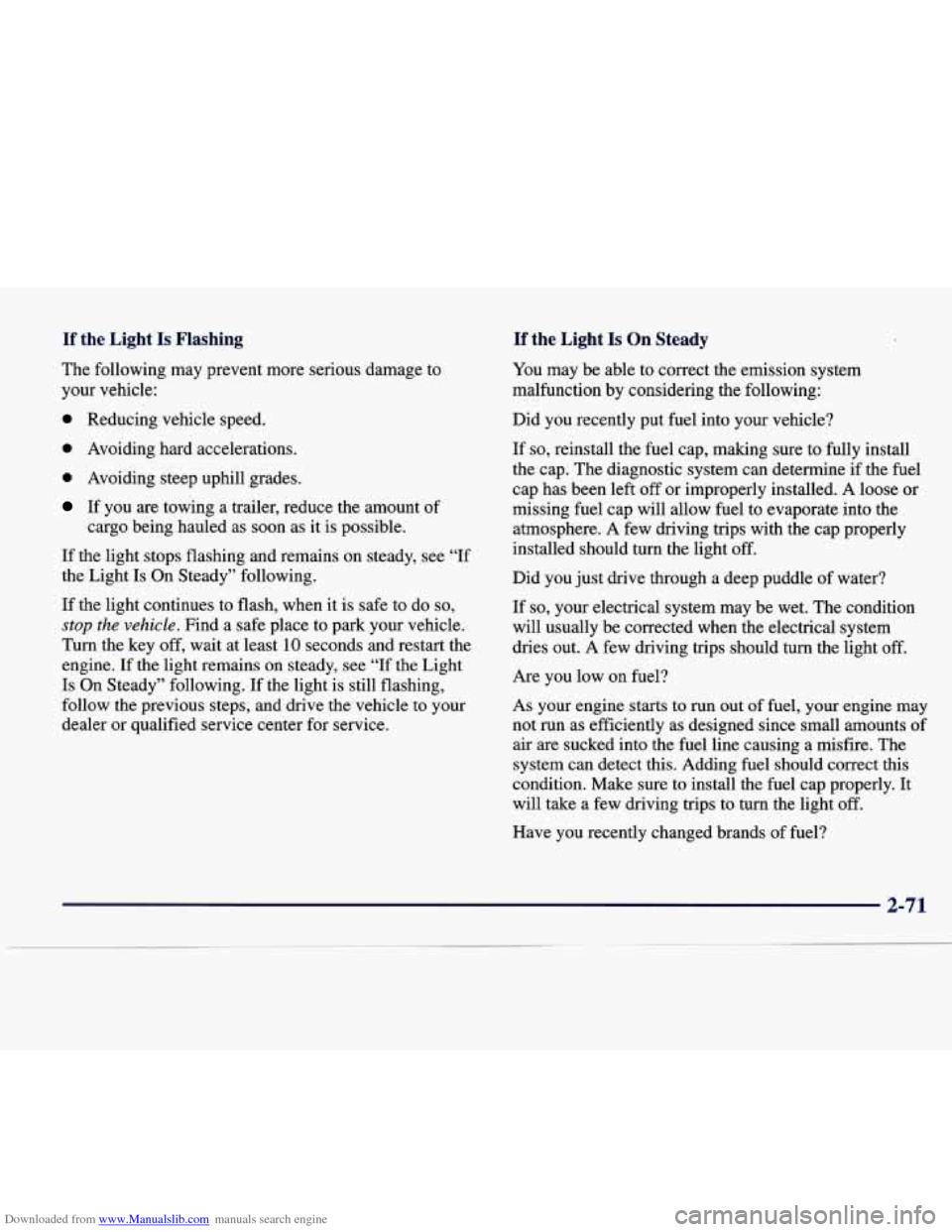
Downloaded from www.Manualslib.com manuals search engine If the Light Is Flashing
The following may prevent more serious damage to
your vehicle:
0 Reducing vehicle speed.
0 Avoiding hard accelerations.
0 Avoiding steep uphill grades.
If the Light Is On Steady
You may be able to correct the emission system
malfunction by considering the following:
Did you recently put fuel into your vehicle?
If
so, reinstall the fuel cap, making sure to fully install
the cap. The diagnostic system can determine
if the fuel
cap has been left
off or improperly installed. A loose or
missing fuel cap will allow fuel to evaporate into the
atmosphere. A few driving trips with the cap properly
installed should turn the light off.
Did you just drive through a deep puddle of water? If you are towing a trailer, reduce the amount of
cargo being hauled as soon as it is possible.
If the light stops flashing and remains on steady, see “If
the Light
Is On Steady” following.
If the light continues to flash, when it is safe to
do so,
stop the vehicle. Find a safe place to park your vehicle.
Turn the key
off, wait at least 10 seconds and restart the
engine.
If the light remains on steady, see “If the Light
Is On Steady” following. If the light is still flashing,
follow
the previous steps, and drive the vehicle to your
dealer or qualified service center for service. If
so, your electrical system may be wet.
The condition
will usually be corrected when the electrical system
dries out.
A few driving trips should turn the light off.
Are you low on fuel?
As your engine starts to run out
of fuel, your engine may
not run as efficiently as designed since small amounts of
air are sucked into the fuel line causing a misfire. The
system can detect this. Adding fuel should correct this
condition. Make sure to install the fuel cap properly. It
will take a few driving trips to turn the light off.
Have you recently changed brands of fuel?